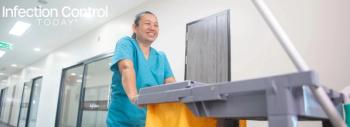
FDA Clearance Marks a New Era for UVC Disinfection in Health Care
The FDA’s new mandate requiring clearance for UVC disinfection devices is reshaping the infection prevention landscape, ensuring only proven, science-backed technologies are used to protect patients.
The FDA’s recent 510(k) clearance of a whole-room UVC microbial reduction device signals a significant shift in how ultraviolet light-based disinfection technologies will be regulated and evaluated moving forward. For the infection prevention field, this development represents both a milestone and a call to action, raising the standards for safety, efficacy, and compliance in health care environments.
"On September 1, 2023, the FDA granted Xenex's LightStrike+ Whole Room Microbial Reduction Device a De Novo classification, Morris Miller, CEO of Xenex told Infection Control Today® (ICT®). "This milestone established that such devices require FDA authorization to ensure safety and effectiveness in clinical settings where critical, semi-critical, and non-critical medical devices are present. Yet nearly 2 years later, UV companies continue to illegally market and sell unauthorized UV devices to healthcare facilities nationwide, which presents real risks to vulnerable patients."
ICT interviewed Gunner Lyslo, CEO and founder of
"It's a huge milestone. It's really a huge milestone for the infection prevention industry in general," Lyslo told ICT.
Traditionally, medical devices must receive FDA authorization before being marketed or sold. However, many UVC disinfection systems had entered the health care market without prior FDA clearance. This was in part due to the absence of an existing regulatory category specific to UVC devices.
Prior to the COVID-19 pandemic, the FDA began examining the proliferation of UVC technologies, many of which made broad claims about efficacy without undergoing rigorous evaluation. The urgency of the pandemic put that process on hold, and the agency temporarily allowed manufacturers to continue marketing products under limited conditions, provided they met basic data and performance requirements for low-level disinfection.
Now that the public health emergency has ended, the regulatory landscape has changed.
"The FDA established a new Class II device classification for the Lightstrike+ and other similar medical devices," Miller said. "As a result of FDA’s device classification action, whole room microbial reduction devices intended for use in the presence of noncritical medical device surfaces, such as hospital beds, wheelchairs, IV poles and many other medical devices common in a health care environment, have been determined to be Class II medical devices that may not be marketed or distributed in the USwithout prior FDA authorization."
Achieving this 510(k)clearance is no small feat, as Lyslo explains. It requires detailed submission of data demonstrating effectiveness at specified distances, angles, and exposure times, along with evaluations of device safety and emissions. Because no predicate category existed previously, the FDA first had to establish one through
As a result, only 2 companies are currently authorized to sell UVC disinfection systems to health care facilities in the US. The vast majority of products on the market lack clearance and may soon be subject to FDA enforcement action.
For health care leaders and infection preventionists, FDA authorization should now be a baseline requirement when evaluating UVC technologies. This shift elevates environmental hygiene and ensures that only scientifically validated tools are deployed to protect patients.
Newsletter
Stay prepared and protected with Infection Control Today's newsletter, delivering essential updates, best practices, and expert insights for infection preventionists.






